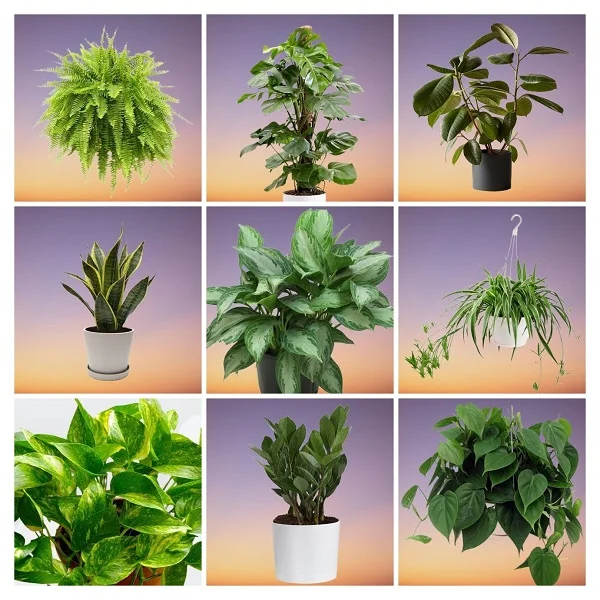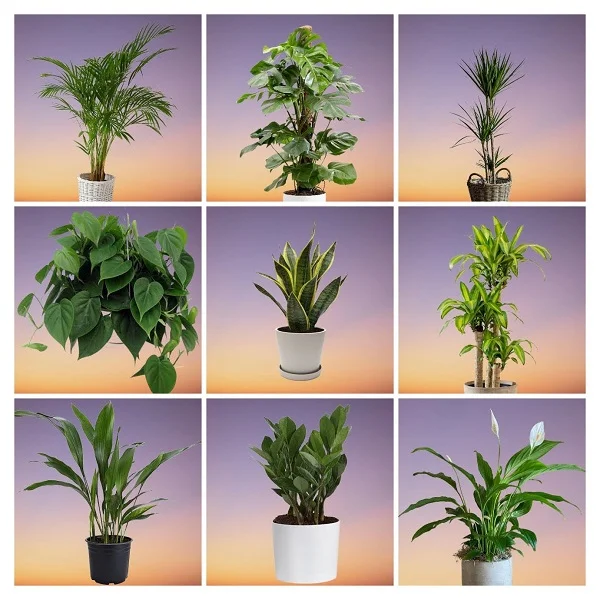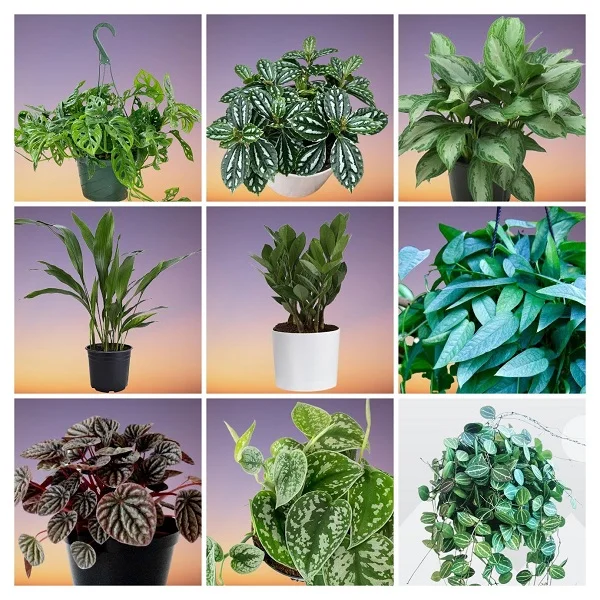Syngonium podophyllum (Arrowhead Vine) Care Indoors, Common Problems & Remedies
Some links in this post may be affiliate links
Syngonium podophyllum care indoors is easy as it requires bright indirect light, average warmth, moderate humidity and consistently moist, rich, well-drained soils coupled with monthly feeding in the growing season.
Arrowhead Vine also called Goosefoot Vine, Arrowhead Plant, African Evergreen, Arrowhead Philodendron, American Evergreen or Nephthytis is among the popular fast-growing plants, perfect for growing in any space.
Arrowhead Plant leaves dramatically change in shape as the plant ages. The young leaves are arrow-shaped and borne on erect stalks, the variegation is boldest and brightest at this stage.
With age the stems acquire a climbing habit and may be upto 5 feet long while the leaves become lobed. Arrowhead Vine is one of the best small plants for the limited spaces.
To maintain Goosefoot Vine in the juvenile form, cut off the climbing stems as they develop. However with age, the stems become leggy requiring to be cutback to rejuvenate growth.
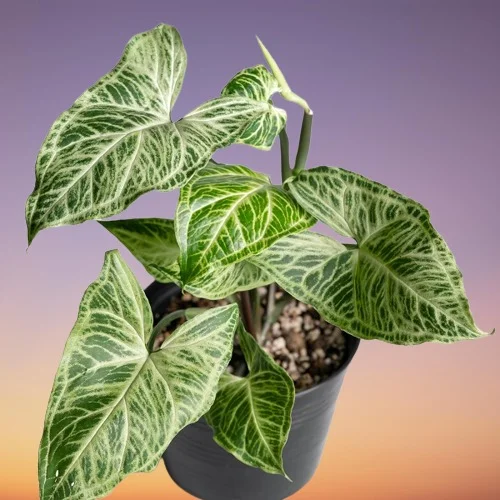
Botanical name: Syngonium podophyllum
Synonym: Nephthytis podophyllum
Family: Araceae
Common names: Arrowhead Plant, Arrowhead Vine, African Evergreen, Arrowhead Philodendron, American Evergreen, Nephthytis
Origin
Syngonium podophyllum is native to a wide tropical region of Latin America from Mexico to Bolivia and naturalized in West Indies, Florida, Texas and Hawaii. It is one the favorite tropical foliage plants for the home and other spaces.
Varieties
Arrowhead Plant has many variegated cultivars; the main difference being in the position and extent of the cream or white markings. Some leaves are almost entirely white, pink or yellow.
The Syngonium varieties with variegated leaves require a more brighter spot but the dark green leaved ones can grow in darker spaces.
Is Syngonium podophyllum poisonous?
Yes. All parts of Syngonium podophyllum are toxic to humans and pets and can cause severe pain in the mouth if eaten. The plant sap contains oxalic acid which can cause severe burning sensations on the skin and eye damage. Always wear gloves when handling the plant to protect yourself and avoid touching the eyes while handling it.
Benefits of Syngonium podophyllum
Versatile growth habit: The plant can grow as a compact tabletop plant or trail beautifully in hanging pots. With support, it climbs gracefully, making it suitable for different indoor styles.
Easy to grow and maintain: It adapts well to different light conditions and does not require complicated care. Its resilience makes it a reliable indoor companion and perfect for beginners.
Aesthetic and decorative appeal: It has attractive, arrow-shaped leaves with shades of green, cream, or pink. Its vibrant foliage enhances any interior décor.
Boosts indoor humidity: The plant naturally adds moisture to the air. Increased humidity helps reduce issues like dry skin, sore throats, and respiratory discomfort.
Where to Buy
Syngoniums are magnificent plants to add to your collection, you may get these plants online from Amazon (Link to Amazon).
How do you care for Syngonium podophyllum indoors?
To care for Syngonium podophyllum indoors, give it bright indirect light (dappled light), warmth of 15-280C, humidity of 50-55% and consistently moist, fertile, well-drained potting soils coupled with monthly feeding during the growing season.
Arrowhead Plant requires regular pruning to keep it neat, to minimize pest and disease infestations and to rejuvenate growth. Annual repotting is necessary for a lush growth. Keep reading for more on these growing conditions and how to achieve them.
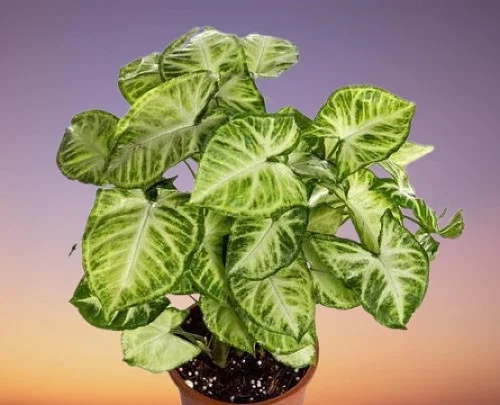
Light Requirements
Where should I place Syngonium podophyllum?
Syngonium podophyllum grows best in bright indirect light (semi-shade). Keep it away from direct sunlight to avoid scorching of the leaves.
The variegated varieties require more brighter light than the all-green varieties. Therefore, where the natural light is not sufficient, you may use full spectrum grow lights to supplement it.
Turn the pot regularly to ensure that the plant receives light on all sides for uniform growth and to prevent lopsided growth.
Watering
How often should I water Syngonium podophyllum?
Water your Syngonium podophyllum liberally in spring and summer while allowing the top 1-2 inches of soil to dry out between waterings. Keep the soil consistently moist but not soggy to prevent rotting, yellowing and plant loss.
Cut down on watering in fall and winter to maintain the soil moderately moist as growth is minimal at this time. Do not allow the soil to dry out completely as it may result in wilting, yellowing and reduced growth.
Use chlorine-free water to prevent browning of leaf edges and tips. Confirm that the water is at room temperature to avoid cold shock which can lead to stunted growth and yellowing.
Make sure that the soil is free-draining and the pot has a drainage hole to prevent the soil from getting soggy as it can lead to root-rot and death of the plant.
Temperature & Humidity
Syngonium podophyllum flourishes in a warmth of 15-280C; a room temperature that is comfortable for you is ideal for the plant.
Keep it away from sources of drafts to prevent sudden changes in the temperature as they can cause reduced growth, yellowing and death of the plant.
Arrowhead Vine thrives in a humidity of 50-55%; too low humidity may lead to brown leaf tips and edges. Therefore, where the air is very dry due to high indoor temperatures, increase humidity; set the pot on a wet pebble tray, group the plants together or use a humidifier. Maintain good air circulation to prevent fungal diseases.
Fertilizer
Feed your Arrowhead Plant with a balanced, liquid fertilizer monthly in spring and summer for a lush growth. Do not feed in fall and winter as growth is reduced and it can lead to fertilizer burn and death of the plant.
Potting Soil
The best soil for Syngonium podophyllum should be rich in organic matter and free-draining to prevent it from getting soggy while providing the required nutrients. A blend of 2 parts all purpose potting mix and 1 part perlite (for drainage) is ideal for this plant.
Repotting
For a large vigorously growing Arrowhead Plant, repot once a year at the beginning of the growing season (spring to early summer) to prevent it from getting pot-bound. Being pot-bound will cause the growth to slow down; it does not like to be crowded.
Select a pot one size larger than the current one. Make sure that the pot has a drainage hole and the soil is well-drained to prevent excessive wetness which can result root-rot and death of the plant.
Syngonium podophyllum is a vining plant making it ideal for a hanging basket where the the stems can cascade downwards beautifully. Check out these hanging planters with macrame hangers on Amazon.
Pruning & Grooming
Pruning Arrowhead Vine involves removal of yellow and dead leaves to reduce pest and disease infestations as well as keep the plant neat and tidy.
To make your Syngonium bushy, regularly pinch off the growing tips at a point just below a leaf node (where new shoots will sprout from). In addition, cutback the stems when they become leggy to encourage new growth.
Regularly clean the leaves by damp-wiping with a soft cloth to get rid of dust as well as reduce infestation by pests and diseases.
Syngonium podophyllum Propagation
Syngonium podophyllum (Arrowhead Plants) propagation is done from stem cuttings or by plant division. The best time to propagate is at the beginning of the growing season when the plant has enough food reserves which are necessary for faster establishment of the new plant.
Learn how to propagate Syngonium (Arrowhead Plants) by 3 easy methods.
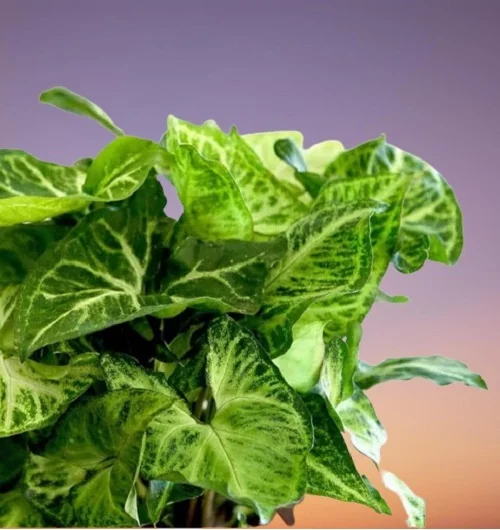
Syngonium podophyllum Common Problems & Solutions
Syngonium podophyllum common problems are yellow leaves, plant dying, leggy growth, brown leaf tips and edges, weeping at the leaf tips, pests and diseases among others. Keep reading for more on these problems, their reedies and solutions.
Yellow leaves
Why are the leaves on my Syngonium turning yellow?
The main causes of yellow leaves on your Syngonium are overwatering, soggy soil, too little light, nutrient deficiency or temperature stress.
How to fix it
Overwatering: Do not water on a schedule. Water only when the top 1-2 inches of soil dry.
Soggy soil: Use a well-draining soil and a pot that has a drainage hole.
Too lttle light: Move the plant to a brighter spot where it will receive bright indirect light or use a grow light.
Nutrients deficiency: Apply a balanced, water-soluble fertilizer every 4 weeks in spring and summer.
Temperature stress: Keep the plant away from drafts emanating from hot surfaces, hot air vents, AC units, windy doors among others.
Plant dying
Why is my Syngonium suddenly dying?
Your Syngonium is suddenly dying due to root-rot disease which is prevalent in soggy soil. It is characterized by yellowing and wilting leaves, rapidly followed by browning and plant collapse.
How to fix it
- Carefully slip the plant out of its pot and inspect the roots.
- Trim the brown-black, mushy roots and treat the healthy roots with a copper-based fungicidal solution as indicated by the manufacturer.
- Disinfect the pot with the fungicidal solution or use a fresh pot to repot the plant in fresh, well-draining soil.
- Do not water the plant immediately; keep it dry for 5-7 days before you can resume watering.
- Use a pot with a drainage hole and well-draining soil to prevent the soil from getting soggy.
- Reduce watering in fall and winter as growth is slowed at this time to keep the soil barely moist.
Leggy growth
Why is my Syngonium so leggy?
Leggy growth on your Syngonium podophyllum is caused by too little light, nutrients deficiency, lack of pruning or underwatering.
How t fix it
Too little light: Position the plant in a brighter spot or instal a grow light if the natural lighting is not adequate.
Nutrients deficiency: Feed the plant with a balanced, liquid fertilizer every 4 weeks in spring and summer.
Lack of pruning: Regularly pinch off the growing tips to encourage bushyness. Cutback the leggy stems at the beginning of the growing season (spring) to rejuvenate growth.
Underwatering: Maintain the soil consistently moist in spring and summer and slightly moist in fall and winter. Never allow the soil to dry out completely.
Brown leaf tips and edges
Brown leaf tips and edges on your Arrowhead Plant are caused by too dry air or being pot-bound.
How to fix it
Too dry air: Group the plants together, set the pot on a wet pebble tray or use a humidifier. You may also grow the plant in a well-lit bathroom, kitchen, laundry area and other humid areas.
Being pot-bound: Repot the plant into a larger pot. Ensure that the pot has a drainage hole and the soil is free-draining to prevent rotting.
Weeping at the leaf tips and edges
Weeping at the leaf tips and edges on Arrowhead Vine is caused by too wet soil (soggy soil).
How to fix it
Allow the soil to dry out between waterings and reduce frequency of watering.
Ensure that the soil is free-draining and the pot has a drainage hole to prevent the soil from getting soggy.
Pests
Common pests on Syngonium are mealybugs, aphids and spider mites which are prevalent in too dry conditions.
How to fix it
- Isolate the affected plant to prevent spread to the other plants.
- Treat the affected plant with neem oil or insecticidal soap as per the manufacturers' instructions.
- Regularly check underneath and between the leaves for these pests and carry out timely control measures.
- Maintain the plant well pruned and upscale humidity to discourage the pests.
Rotting stems
Rotting stems on Arrowhead Vine is an indication of the crown and stem rot disease which is enhanced by too wet soil coupled with too little warmth. You may save the plant by repotting and keeping the soil dry and warm for some time before resuming watering.
Frequently Asked Questions
1. How to make Syngonium grow faster?
- Give it bright indirect light and keep it away from direct sunlight.
- Water when the top 1-2 inches of soil dry out. Do not allow the soil to dry out completely neither to be soggy.
- Pot it in a pot with a drainage hole and well-draining soil to prevent waterlogging.
- Maintain a humidity of 50-55% and a warmth of 15-280C.
- Fertilize monthly in spring and summer with a balanced, water-soluble fertilizer.
- Repot it when it becomes overcrowded; do not allow it to become pot-bound.
- Pinch off the growing tips regularly and cutback the stems when they get leggy.
- Regularly inspect it for pests and diseases and carry out timely control measures.
2. Do Syngoniums like direct sunlight?
No. Syngoniums will burn in direct sunlight, they thrive in bright indirect light.
3. Do Syngoniums like to climb?
Yes. Syngoniums are vining plants with varied growth habits. In the wild, they grow by climbing or by crawling on the ground.
4. Do Syngoniums like a moss pole?
You may provide a moss pole for your Syngoniums if you need them to climb. They also look great in a hanging basket where the stems can hang down beautifully.
5. Can you grow Syngonium in water without soil?
Yes. It is possible to grow Syngoniums in water, but for a strong, healthy growth, you may need to grow them in soil.
6. How do you make Syngonium bushy?
Regularly pinch off the grow tips and cutback the leggy stems at the beginning of the growing season. In addition provide adequate light to enhance growth.
7. What is the maximum size of Syngonium?
Indoors, Syngonium can grow to a height of 3-4 feet and a spread of 3-6 feet.
8. Do Syngonium like being root-bound?
No. Syngonium are fast-growing plants which do not like to be root-bound. They need to be repotted annually to provide adequate room for growth.
9. What are the disadvantages of Syngonium plants?
One disadvantage of Syngonium Plants is that they are toxic to humans and pets. Their sap contains oxalic acid which can cause severe pain in the mouth if eaten and severe burning sensations on the skin.
10. Can you grow Syngonium from cuttings?
Yes. Syngonium are easily propagated from stem cuttings which can be rooted either in water or in soil.
You liked it? Share on social media.
Related Content
Amazon Associates Disclosure
Homeplantsguide.com is a participant in the Amazon Services LLC Associates Program, an affiliate advertising program designed to provide a means for sites to earn advertising fees by advertising and linking to amazon.com.



